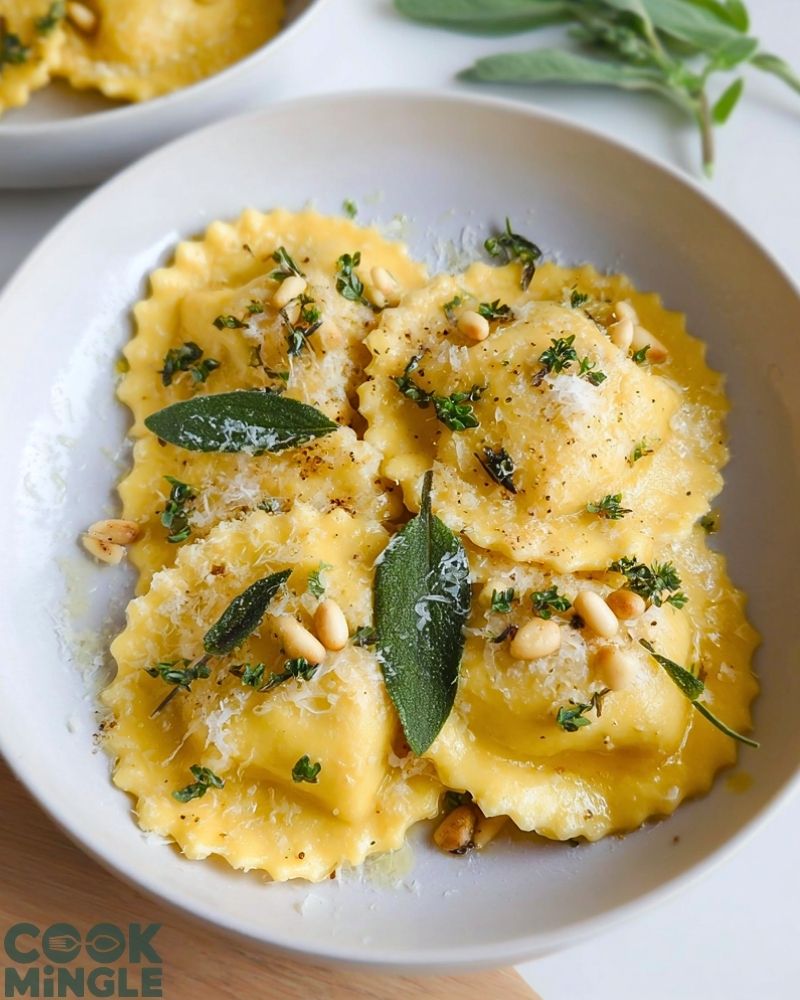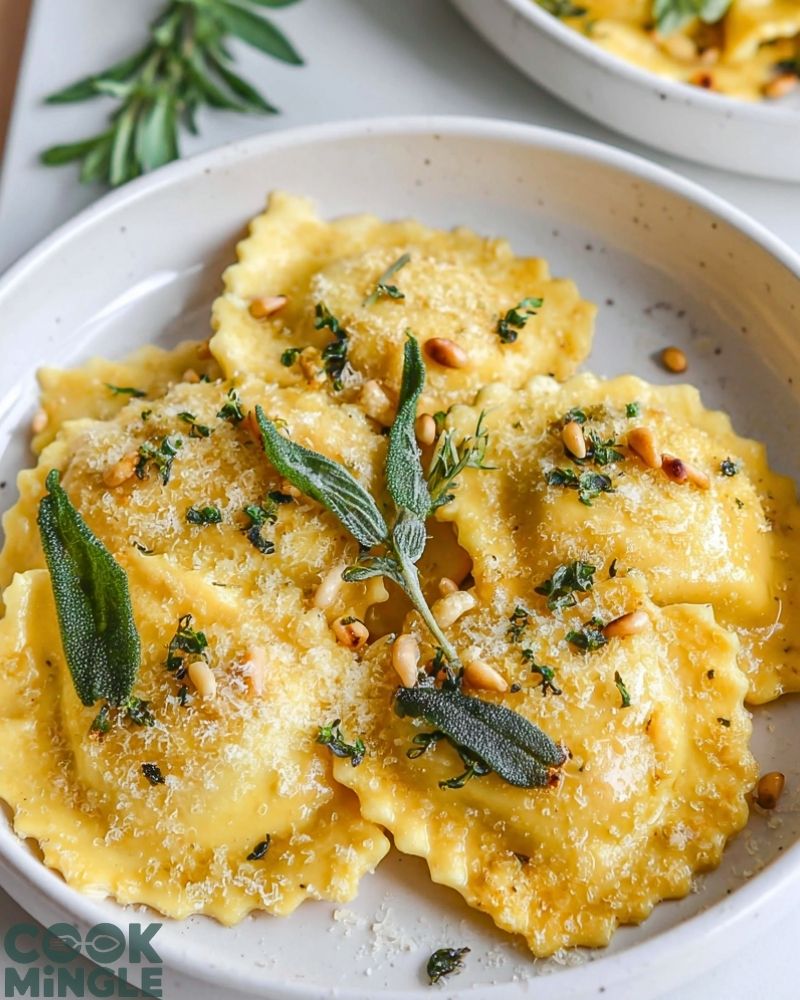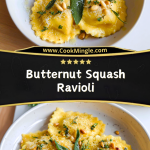Butternut Squash Ravioli is the kind of dish that instantly brings warmth and elegance to your table. With its silky pasta pockets filled with sweet roasted butternut squash and hints of nutmeg, this recipe is all about comfort with a gourmet twist. Drizzled in browned butter infused with crispy sage leaves and a sprinkle of nutty Parmesan, it’s the kind of meal that turns an ordinary evening into something special.

Whether you’re hosting a fall dinner party or just craving something rich and seasonal, this ravioli delivers layers of flavor that are earthy, slightly sweet, and satisfyingly savory. Each bite is a beautiful balance of textures — tender pasta, creamy filling, crunchy pine nuts, and a whisper of browned butter that ties it all together.
Why You’ll Love This Butternut Squash Ravioli
- Autumn-Inspired Flavor: The natural sweetness of roasted butternut squash pairs perfectly with nutmeg, sage, and butter.
- Elegant Yet Easy: While it looks impressive, it’s surprisingly manageable whether you use store-bought pasta or make your own.
- Versatile for Occasions: Serve it as a cozy weeknight dinner, or elevate it with garnishes for a festive holiday meal.
- Vegetarian-Friendly: It’s a satisfying meatless option that doesn’t compromise on taste or texture.
- Customizable: Add ricotta for extra creaminess or toss in caramelized onions for a richer filling.
Preparation Phase & Tools to Use (Essential Tools and Equipment, and Their Importance)
Creating a delicious plate of Butternut Squash Ravioli requires a few key tools that make the process smoother and more enjoyable:
- Rolling Pin or Pasta Machine: If you’re making fresh pasta, a pasta machine ensures even, thin sheets that are crucial for delicate ravioli. A rolling pin can do the job too, though with a bit more effort.
- Food Processor or Blender: For a silky-smooth squash filling, a food processor is your best friend. It helps incorporate all the ingredients evenly for a creamy texture.
- Ravioli Cutter or Pasta Wheel: This not only seals the ravioli securely but also gives them that classic fluted edge.
- Pastry Brush: Helps in sealing the pasta edges with water or egg wash to prevent them from opening while cooking.
- Large Pot: Essential for boiling the ravioli without overcrowding.
- Slotted Spoon: To gently lift ravioli out of the boiling water without breaking them.
- Sauté Pan: Needed for browning the butter and crisping the sage leaves for your finishing sauce.
Preparation Tips
- Roast the Butternut Squash for Depth: Roasting brings out the squash’s natural sugars and adds a richer, caramelized flavor to the filling.
- Drain Excess Moisture: Make sure the squash is not too watery. If needed, let the purée sit in a sieve before mixing with other ingredients.
- Don’t Overfill the Ravioli: A teaspoon or so of filling per ravioli is ideal. Too much can cause them to burst open during boiling.
- Seal Thoroughly: Press out all the air when sealing to avoid air pockets that can explode while cooking.
- Cook in Batches: Don’t overcrowd the pot—boil ravioli in small batches to avoid them sticking together or tearing.
- Brown Butter Slowly: Let the butter cook over medium-low heat until golden and nutty, then immediately remove from heat to prevent burning.
Ingredients for This Butternut Squash Ravioli
For the Ravioli Dough (if making fresh pasta):
- 2 cups all-purpose flour
- 3 large eggs
- 1 tablespoon olive oil
- 1/2 teaspoon salt
For the Butternut Squash Filling:
- 2 cups roasted butternut squash (about 1 small squash)
- 1/2 cup grated Parmesan cheese
- 1/4 cup ricotta cheese (optional, for creaminess)
- 1/4 teaspoon ground nutmeg
- Salt and pepper, to taste
For the Brown Butter Sage Sauce:
- 6 tablespoons unsalted butter
- 6–8 fresh sage leaves
- 2 tablespoons pine nuts (lightly toasted)
- Freshly grated Parmesan, for topping
- Optional: a pinch of lemon zest for brightness
Optional Garnishes:
- Cracked black pepper
- Extra grated Parmesan
- Additional fresh herbs like thyme or rosemary

Step 1: Roast the Butternut Squash
Preheat your oven to 400°F (200°C). Cut the butternut squash in half, remove the seeds, and place it cut-side down on a lined baking sheet. Roast for 40–45 minutes, or until the flesh is fork-tender. Let it cool slightly, then scoop out the flesh and mash or purée until smooth.
Step 2: Prepare the Filling
In a mixing bowl or food processor, combine the mashed squash, Parmesan, optional ricotta, nutmeg, salt, and pepper. Blend until creamy and well incorporated. Taste and adjust seasoning if needed.
Step 3: Make the Pasta Dough
On a clean surface, form the flour into a mound with a well in the center. Crack the eggs into the well, add the olive oil and salt. Gradually mix with a fork, drawing in flour from the edges. Knead until smooth (about 8–10 minutes). Wrap in plastic and let rest for 30 minutes.
Step 4: Roll and Fill the Ravioli
Roll out your dough using a pasta machine or rolling pin to about 1/16 inch thick. Cut into sheets. Place small scoops of filling (about 1 teaspoon each) evenly spaced on one sheet, cover with another sheet, and press around each mound to seal, pushing out air bubbles. Cut with a ravioli cutter or knife.
Step 5: Boil the Ravioli
Bring a large pot of salted water to a gentle boil. Drop in ravioli in batches and cook for 3–4 minutes or until they float. Remove with a slotted spoon and set aside on a plate.
Step 6: Make the Brown Butter Sage Sauce
In a large sauté pan over medium heat, melt the butter. Add sage leaves and cook until the butter turns golden and aromatic, and the leaves become crisp (about 4–5 minutes). Stir in the toasted pine nuts.
Step 7: Plate and Serve
Add the cooked ravioli to the pan and gently toss in the sauce to coat. Plate the ravioli, spoon over extra brown butter and sage, and sprinkle with Parmesan and black pepper. Serve immediately.
Notes
- You can prepare the squash filling a day ahead and refrigerate it to save time.
- Store-bought fresh pasta sheets or wonton wrappers work well as shortcuts if you’re not making your own dough.
- Add a pinch of chili flakes to the butter sauce if you enjoy a bit of heat.
- For a nut-free version, omit pine nuts or substitute with roasted sunflower seeds.
- Ricotta makes the filling lighter and creamier, but you can skip it for a more dense, squash-forward flavor.
- If freezing, place assembled (uncooked) ravioli on a tray until solid, then transfer to a freezer-safe bag.
Watch Out for These Mistakes While Cooking
- Overstuffing the Ravioli: Too much filling makes them harder to seal and more likely to break during cooking.
- Not Sealing Properly: Any trapped air or loose edges can cause the ravioli to open in boiling water.
- Using Wet Filling: Moisture in the filling can leak into the pasta, weakening it. Drain excess liquid from squash or ricotta.
- Boiling Too Vigorously: A hard boil can cause delicate ravioli to tear. Keep the water at a gentle boil or simmer.
- Burning the Butter: Brown butter can quickly turn to burnt butter. Watch it closely and remove from heat once golden.
- Skipping the Rest Time for Dough: Resting allows gluten to relax, making the dough easier to roll and preventing shrinkage.
- Stacking Fresh Ravioli: They can stick together. Keep them spaced out on a floured tray until ready to cook.
- Overcooking the Ravioli: They only need 3–4 minutes. Overcooked ravioli become mushy and may fall apart.
What to Serve With Butternut Squash Ravioli?
Here are 8 Recommendations:
- Arugula and Pear Salad
A light, peppery salad with juicy pears, walnuts, and balsamic vinaigrette perfectly contrasts the rich ravioli. - Garlic Roasted Broccolini
Slightly charred broccolini brings a bitter edge that balances the sweet and buttery squash. - Crusty Artisan Bread
Great for soaking up the brown butter sauce and adding texture to the meal. - White Wine (Chardonnay or Pinot Grigio)
A crisp glass of wine pairs wonderfully with the creamy filling and sage butter. - Toasted Hazelnut Brussels Sprouts
Roasted sprouts with nutty hazelnuts echo the pine nuts and deepen the flavor profile. - Simple Tomato Basil Soup
Adds a refreshing acidity and makes the meal more filling without overwhelming the palate. - Parmesan-Crusted Zucchini
Baked or pan-fried, these add crunch and a cheesy side that complements the pasta. - Apple Cider Spritzer or Sparkling Water with Citrus
A bright, non-alcoholic pairing that cuts through the richness of the dish.
Storage Instructions
Refrigeration: If you have leftover cooked ravioli, store them in an airtight container in the refrigerator for up to 3 days. Reheat gently in a skillet with a splash of water or extra butter.
Freezing: Uncooked ravioli freeze beautifully. Lay them in a single layer on a parchment-lined baking sheet and freeze until solid (about 1–2 hours). Then transfer to a freezer bag or container. Cook from frozen, adding 1–2 extra minutes to the boiling time.
Avoid Refrigerating Raw Dough: Raw pasta dough is best used fresh or frozen if needed. It can become overly dry or sticky in the fridge.
Estimated Nutrition (Per Serving – approx. 6 ravioli with sauce)
- Calories: 420 kcal
- Protein: 11g
- Fat: 23g
- Saturated Fat: 10g
- Carbohydrates: 44g
- Sugar: 4g
- Fiber: 3g
- Cholesterol: 100mg
- Sodium: 280mg
Note: Nutritional values may vary depending on exact ingredients and portion sizes used.
Frequently Asked Questions
1. Can I use canned butternut squash instead of fresh?
Yes, canned butternut squash purée works in a pinch, but roasting fresh squash offers a deeper, richer flavor.
2. What can I use if I don’t have a ravioli cutter?
You can use a sharp knife or even a cookie cutter. Just make sure to press the edges well with a fork to seal.
3. Is it okay to make the ravioli ahead of time?
Absolutely! You can make and freeze them uncooked, or store the filling and pasta separately and assemble later.
4. Can I make this dish vegan?
Yes—use vegan pasta dough, omit the cheese, and replace butter with vegan butter or olive oil.
5. What sauce alternatives work with this ravioli?
A light cream sauce, sage pesto, or even a drizzle of truffle oil are excellent alternatives to the brown butter sauce.
6. How do I know when the ravioli are done cooking?
When they float to the top of the pot and the dough looks tender and slightly translucent, they’re ready.
7. Can I bake the ravioli instead of boiling?
Not recommended—ravioli are best boiled. Baking is better for filled pastas like lasagna.
8. How many ravioli does this recipe make?
You’ll get about 30–35 ravioli, depending on the size of your cut and how thin you roll the dough.
Conclusion
Butternut Squash Ravioli is a standout dish that brings together rustic ingredients with refined elegance. Whether you’re rolling fresh dough or using shortcuts, every step is worth the final result—a comforting, aromatic, and deeply satisfying plate of pasta. It’s one of those meals that feels like a cozy autumn evening wrapped up in a bite, ready to impress anyone lucky enough to share it with you.

Butternut Squash Ravioli
- Total Time: 1 hour 5 minutes
- Yield: 4 servings
- Diet: Vegetarian
Description
Butternut Squash Ravioli is a cozy and elegant dish, featuring sweet roasted squash wrapped in tender pasta and finished with a rich brown butter sage sauce. It’s perfect for autumn dinners or a holiday centerpiece.
Ingredients
2 cups all-purpose flour
3 large eggs
1 tablespoon olive oil
1/2 teaspoon salt
2 cups roasted butternut squash
1/2 cup grated Parmesan cheese
1/4 cup ricotta cheese
1/4 teaspoon ground nutmeg
Salt and pepper to taste
6 tablespoons unsalted butter
6–8 fresh sage leaves
2 tablespoons pine nuts
Freshly grated Parmesan for topping
Optional: a pinch of lemon zest
Instructions
1. Preheat oven to 400°F (200°C). Roast butternut squash cut-side down for 40–45 minutes. Scoop and purée.
2. Combine squash, Parmesan, ricotta (optional), nutmeg, salt, and pepper. Mix until smooth.
3. Make pasta dough by mixing flour, eggs, olive oil, and salt. Knead for 8–10 minutes. Rest 30 minutes.
4. Roll out dough thinly. Spoon filling, seal with another layer, and cut ravioli.
5. Boil salted water. Cook ravioli in batches for 3–4 minutes until they float.
6. Melt butter in pan. Add sage leaves and cook until crisp and butter is golden. Stir in pine nuts.
7. Toss cooked ravioli in sauce. Plate with Parmesan and pepper. Serve warm.
Notes
Store leftovers in fridge for up to 3 days. Freeze uncooked ravioli for longer storage.
Use fresh squash for deeper flavor. Don’t overfill ravioli to avoid bursting.
Add chili flakes to the sauce for heat. Use sunflower seeds instead of pine nuts for nut-free version.
- Prep Time: 45 minutes
- Cook Time: 20 minutes
- Category: Dinner
- Method: Boiling
- Cuisine: Italian
Nutrition
- Serving Size: 6 ravioli
- Calories: 420
- Sugar: 4g
- Sodium: 280mg
- Fat: 23g
- Saturated Fat: 10g
- Unsaturated Fat: 12g
- Trans Fat: 0g
- Carbohydrates: 44g
- Fiber: 3g
- Protein: 11g
- Cholesterol: 100mg

